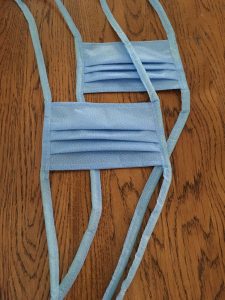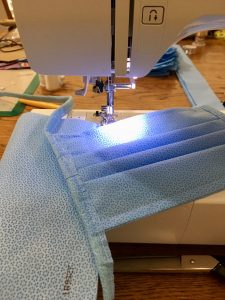A face mask reduces coronavirus transmission but doesn't protect the eyes
To reduce the spread of coronavirus, federal health officials now recommend that Americans wear non-medical cloth face masks when they’re out in public.
Face masks, however, don’t offer complete protection because they don’t shield the wearer’s eyes, says the coronavirus response coordinator for the White House.
CDC recommends cloth face masks
President Trump announced earlier this month that the Centers for Disease Control and Prevention (CDC) had reversed its stance and suggested — but did not mandate — that Americans put on non-medical face coverings when they leave home.
President Trump, however, said he wouldn’t be wearing a non-medical mask. “Basically, it’s a voluntary thing,” the president told reporters.
Face masks, other measures fight coronavirus transmission
Dr. Deborah Birx, the coronavirus response coordinator for the White House, warned about the limitations of wearing a non-medical face mask to battle the coronavirus.
At a press briefing, she advised that wearing a cloth mask over your nose and mouth must be coupled with other anti-coronavirus measures.
“The most important thing is the social distancing and washing your hands,” Birx said.
“And we don’t want people to get an artificial sense of protection because they’re behind a mask,” she said. “Because if they’re touching things — remember, your eyes are not in the mask — so, if you’re touching things and then touching your eyes, you’re exposing yourself in the same way.”
WORRIED ABOUT YOUR EYES? Call an eye doctor near you and ask for a virtual visit or schedule a safe eye exam.
Coronavirus transmission through the eyes
The novel coronavirus causes COVID-19, a potentially fatal respiratory illness. It’s thought that the virus can spread through contact with any mucous membrane, including the conjunctiva — the clear, thin membrane that covers part of the front of the eye as well as the inner part of the eyelids — according to the American Optometric Association.
Transmission is most likely through the mouth or nose but the conjunctiva makes the eye another possible transmission site for COVID-19. Without eye protection — such as glasses, goggles or a face shield — in addition to your face mask, your eyes will not be guarded from coronavirus.
SEE RELATED: Coronavirus: How eyes may play a role in its spread
How face masks can reduce coronavirus transmission
The federal government had previously recommended against the general public wearing masks to combat the coronavirus. The exceptions were people with COVID-19 symptoms (including fever and coughing) and people spending time around COVID-19 patients.
“Based on the best evidence available at the time, it was not deemed that it would have a significant impact on whether or not a healthy person wearing a mask would contract COVID-19,” Dr. Jerome Adams, the U.S. surgeon general, said April 3.
New evidence indicates people who are infected with the coronavirus but aren’t exhibiting symptoms can transmit the virus to others, Adams said.
Therefore, to decrease the spread of the virus, Americans should consider wearing cloth masks in places where it’s difficult to practice social distancing, such as grocery stores and pharmacies, he said.
“In normal times, we’d say that if it wasn’t shown statistically significant or effective in real-world studies, we don’t recommend it,” Dr. Don Milton, a professor of applied environmental health at the University of Maryland, said in an April 2020 news release.
“But in the middle of a pandemic, we’re desperate,” he continued. “The thinking is that even if it cuts down transmission a little bit, it’s worth trying.”
How to make or where to buy cloth face masks
Cloth masks can be made at home or purchased from a retailer. Health care provider Kaiser Permanente offers tips on how to create a DIY cloth mask.
As an alternative to a handmade or machine-made cloth mask, consider using a bandana, scarf or handkerchief as a mask that covers your nose and mouth.
Keep in mind that cloth masks and similar face coverings are meant to prevent a wearer from transmitting the virus to others but not to prevent the wearer from becoming infected.
Who shouldn’t wear face masks
The CDC says those who should not wear cloth face coverings are:
Children under age 2.
Anyone who has trouble breathing.
Anyone who is unconscious, incapacitated or otherwise unable to remove a mask on their own.
Cloth face masks’ effectiveness against coronavirus transmission
According to a Washington Post opinion piece written by a professor at Harvard University’s T.H. Chan School of Public Health, DIY cloth masks can be 50% to 70% effective at blocking infected droplets when a wearer coughs, sneezes or speaks. The effectiveness depends upon factors such as the fabric thickness and the proper fit around the nose and mouth.
Standard medical masks, such as N95 respirators and surgical masks, should be reserved for health care workers and first responders, health officials say.
Caring for and wearing your cloth face mask
If you’re going to wear a mask in public, you should wash your hands before putting it on, Adams said, so that you get rid of germs like the coronavirus and they don’t wind up on your face.
If you don’t have access to soap and water, use alcohol-based hand sanitizer as recommended by the World Health Organization.
In addition, Adams advised against touching your face when you’re wearing a mask because you could touch a surface where the coronavirus is present and then transfer the virus to your face.
“Remember, this is all about me protecting you and you protecting me,” Adams said at the April 3 briefing. “This is about us coming together as communities.
“If people voluntarily choose to wear a face covering, they’re wearing it to protect their neighbors from getting the coronavirus because they could have asymptomatic spread,” Adams said.
SEE RELATED: Most common coronavirus eye symptoms
Face mask guidelines and how to avoid a fine
Before the CDC issued new face mask guidelines, a number of health care professionals and government leaders around the U.S. were calling for the general public to cover their faces when they’re away from home. This included the mayors of Los Angeles and New York City.
The City Council in Laredo, Texas, went so far as to require anyone over age 5 to wear a covering over their nose and mouth — such as a homemade mask, scarf, bandana or handkerchief — when they’re out in public. Violating this ordinance can result in a fine of up to $1,000.
In recent weeks. Los Angeles, Austin and Dallas are among several cities that now require face masks when people are out in public.
Face masks are ‘just another layer of protection’
No matter what the guideline, the goal of any CDC recommendation is to slow the spread of the virus.
In summary, a mask works to contain transmission of the virus to others because it acts as a barrier to outgoing respiratory droplets. An additional benefit of a mask is that it may prevent one from touching their face and increasing the likelihood of transmission through mucous membranes.
As Dr. Adams stated, the mask is another layer of protection for us to help keep each other safe.
ARE YOUR EYES WATERY OR RED? HAVING TROUBLE SEEING?
If you live anywhere in Volusia or Flagler Counties in Florida, call the Precision Eye Institute with two locations to serve our patients.


